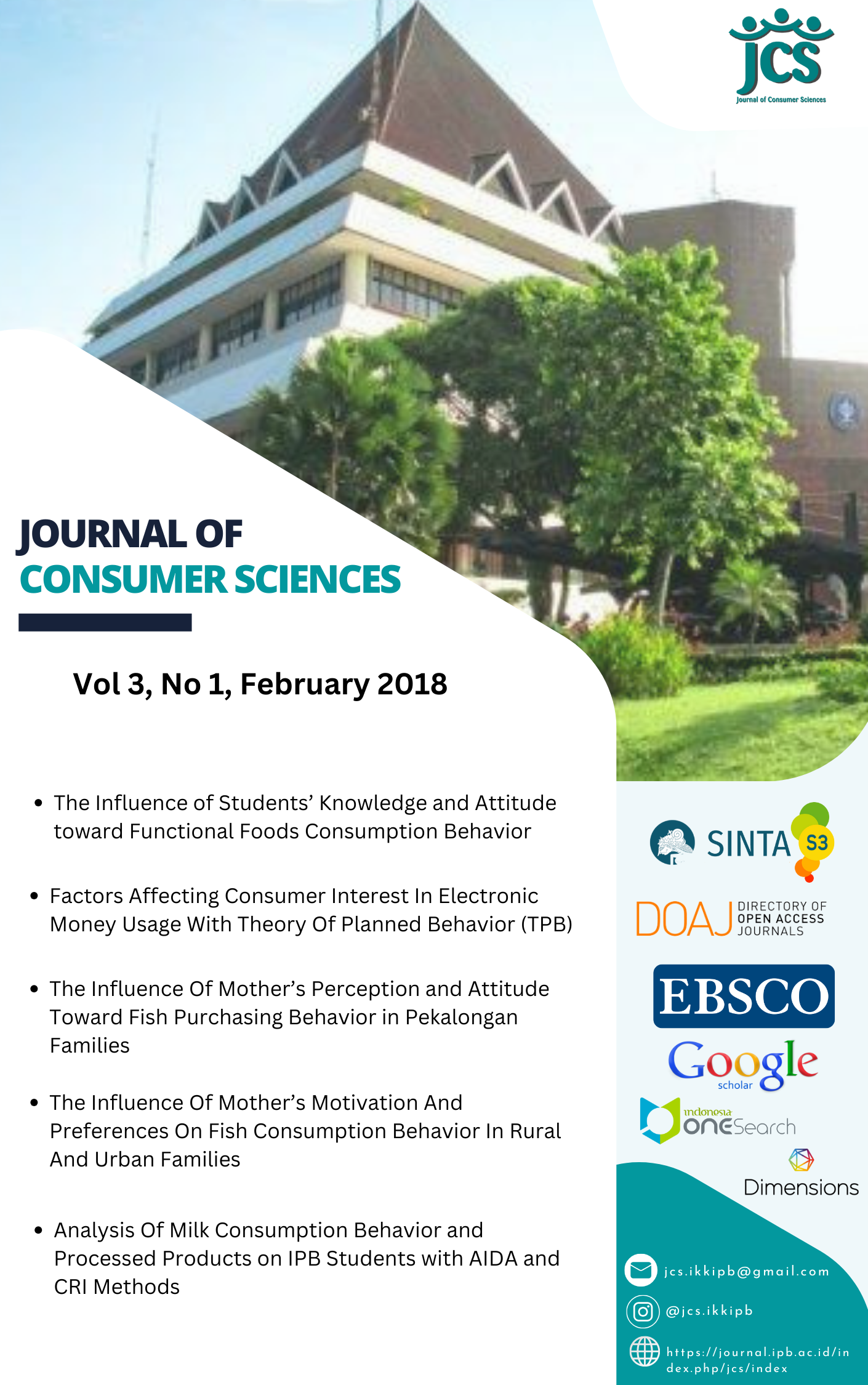Factors Affecting Consumer Interest In Electronic Money Usage With Theory Of Planned Behavior (TPB)
Abstract
References
Ajzen, I. (2005). Attitudes personality and behavior (2nd edition).Berkshire. UK. Open University Press-McGraw Hill Education.
Alam S.S., &Sayuti N.M. (2011). Applying the theory of planned behavior (TPB) in halal food purchasingn [Abstract]. International Journal of Commerce and Management, 21 (1), 8-20.
Annilda, F. (2017). Faktor yang mempengaruhi minat pengguna internet banking pada usia produktif di Bank XYZ Bogor.Tesis. Bogor. Sekolah Pascasarjana Institut Pertanian Bogor.
Bank Indonesia.(2009). Meta data. Retrieved from http://www.bi.go.id/id/statistik/metadata/sistem-pembayaran/Documents/MetadataEMoney.pdf
Burhanudin.(2015). Aplikasi theory of planned behavior pada intensi mahasiswa untuk berwirausaha.Jurnal Bisnis dan Ekonomi, 6 (1), 60-72.
Cruz, L., Suprapti NWS, &Yasa NYK. (2015). Aplikasi theory of planned behavior dalam membangkitkan niat berwirausaha bagi mahasiswa fakultas ekonomi UNPAZ, Dili, Timor Leste.E-Jurnal Ekonomi dan Bisnis Universitas Udayana, 4 (12), 895-920.ISSN : 2337-3067.
Farida, I., &Mahmud.(2014). Pengaruh theory of planned behavior yang berdampak pada intensi berwirausaha mahasiswa.Economics & Business Research Festival.ISBN : 978-979-3775-555-5
Fatmasari, D., &Wulandari, S. (2016). Analisis faktor-faktor yang mempengaruhi minat mahasiswa dalam penggunaan APMK.Jurnal Penelitian Hukum Ekonomi Syariah, 4 (1). ISSN P: 2355-0805 ISSN E:2549-4112.
Handika, M.F.D., &Sudaryanti, D. (2017).Analisis faktor-faktor yang mempengaruhi niat mahasiswa melakukan tindakan wishtleblowing (studi pada mahasiswa akuntansi STIE Asia Malang).Jurnal Ilmiah Bisnis dan Ekonomi Asia), 11 (1), 56-63.
Haryono, T., Sumarwan, U., Saefuddin, A. & Hartoyo. (2012). Structural model of factors influencing consumer’ intention to use natural gas : an application of planned behaviour theory. Global Advanced Research Journal of Educational Research and Review, 1 (10), 244-252. ISSN: 2315-5132
Hatta, M., Baihaqi, &Rahmahdaniati, R. (2017). Perilaku berbagi pengetahuan akuntansi pada dosen akuntansi kota bengkulu: pendekatan theory of planned behavior (TPB).Jurnal Akuntansi, Ekonomi Dan Manajemen Bisnis,5 (1), 26-44. ISSN : 2548-9836.
Knabe, A.P. (2009). Applying Ajzen’s theory of planned behavior to study of online course adoption in public relations education.Dissertations.Marquette University.
Nazir, M.(1998). Metode Penelitian. Jakarta (ID): Ghalia Indonesia.
Parastiti, D.E., Mukhlis, I.,&Haryono, A. (2015). Analisis penggunaan uang elektronik pada mahasiswa fakultas ekonomi universitas negeri malang (studi kasus: uang elektronik brizzi). Jurnal Ekonomi dan Studi Pembangunan Universitas Negeri Malang, 7 (1).ISN 2502-7115.
Prasastyo, K.W. (2015). Aplikasi theory of planned behavior dalam intensi pembelian apartemen di wilayah Jakarta dengan domisili sebagai variabel moderating.Jurnal Bisnis dan Akuntansi, 17 (02), 134-142. ISSN 1410-9875
Rahmatsyah, D. (2011). Analisa faktor-faktor yang mempengaruhi minat penggunaan produk baru (Studi kasus : uang elektronik kartu flazz BCA). Jakarta. Tesis. Program Studi Magister Manajemen. Fakultas Ekonomi.Universitas Indonesia.
Ramadani, L. (2016). Pengaruh penggunaan Kartu Kredit dan Uang Elektronik (e-money) terhadap pengeluaran konsumsi mahasiswa.Jurnal Ekonomidan Studi Pembangunan, 8 (1). ISSN (P) 2086-1575 E-ISSN 2502-7115.
Riyanti.(2015). Itensi mencontek ditinjau dari theory of planned behavior.Jurnal Ilmiah Psikologi Terapan, 3 (2).ISSN : 2301-8267
Rustam, A., Widya, Y., &Rukhviyanti, N. (2015). Pengaruh minat individu terhadap penggunaan mobile banking (m-banking): model kombinasi technology acceptance model(tam) dan theory of planned behavior (TPB). Jurnal Informatika dan Sistem Informasi, VII (1). ISSN 2085-8795
Simorangkir, E. (2016, Nov 1). Soal Penggunaan Uang Elektronik. RI Masih Kalah dari Malaysia. Detik Finance. Retrieved from https://finance.detik.com/moneter/3334330/soal-penggunaan-uang-elektronik-ri-masih-kalah-dari-malaysia.
Siwinastiti, L.,&Nirmala, T. (2014).Analisis pengaruh penggunaan alat pembayaran menggunakan kartu (APMK) dan uang elektronik (E-Money) terhadap permintaan uang kartal di Indonesia.Jurnal Ekonomi Pembangunan Universitas Lampung, 3 (2), 195-210. ISSN : 2302-9595.
Shih, Y.Y., & Fang, K. (2004). The use of a decomposed theory of planned behavior to study internet banking in taiwan. Internet Research, 14(3), 213-223.
Tjahjono, H. K., Maryati, T., &Fauziyah (2013).Intensi mahasiswa Yogyakarta berwirausaha berbasis teknologi informasi (TI).Jurnal Siasat Bisnis, 17 (1), 17-27. ISSN : 0353 -7565.
Urban, J., Zverinova, I., &Scasny, M. (2012). What motivates czech consumers to buy organic food. Sociologicky Casopis, 48(3),709-736.
Wijayanti, A.W., &Putri, G.A. 2016. Model theory of planned behavior (TPB) untuk memprediksi niat mahasiswa melakukan kecurangan akademik.Jurnal Manajemen dan Kewirausahaan, 14 (2), 189-197
Yulianto, E. (2015, Feb 4). Biaya cetaknya Rp 3.5 triliun setahun. BI: Uang Tolong Dirawat. Detik Finance. Retrieved from http://finance.detik.com/moneter/2823602/biaya-cetaknya-rp-35-triliun-setahun-bi-uang-tolong-dirawat.
Authors
Authors who publish with this journal agree to the following terms:
- Authors retain copyright and grant the journal right of first publication with the work simultaneously licensed under a

This work is licensed under a Creative Commons Attribution 4.0 International License. that allows others to share the work with an acknowledgement of the work's authorship and initial publication in this journal. - Authors are able to enter into separate, additional contractual arrangements for the non-exclusive distribution of the journal's published version of the work (e.g., post it to an institutional repository or publish it in a book), with an acknowledgement of its initial publication in this journal.
- Authors are permitted and encouraged to post their work online (e.g., in institutional repositories or on their website) prior to and during the submission process, as it can lead to productive exchanges, as well as earlier and greater citation of published work (See The Effect of Open Access).







